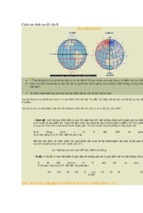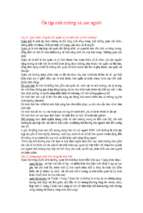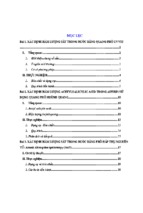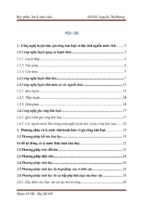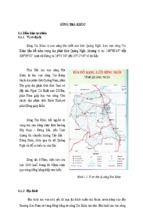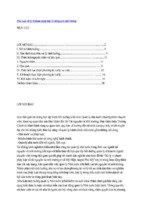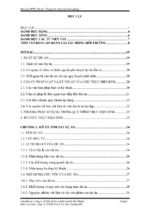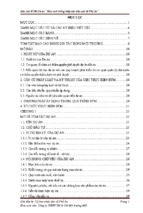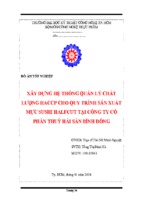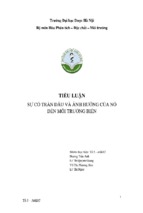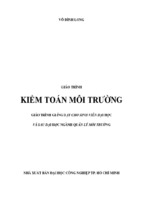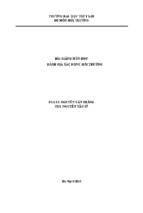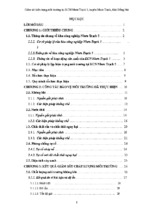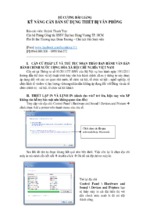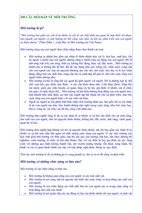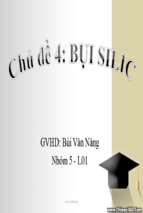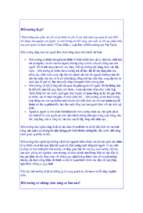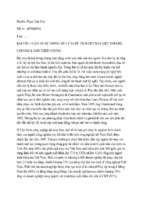Industrial
Noise Control
and Acoustics
Randall F. Barron
Louisiana Tech University
Ruston, Louisiana, U.S.A.
Marcel Dekker, Inc.
New York • Basel
Copyright © 2001 by Marcel Dekker, Inc. All Rights Reserved.
Copyright © 2003 Marcel Dekker, Inc.
Library of Congress Cataloging-in-Publication Data
A catalog record for this book is available from the Library of Congress.
ISBN: 0-8247-0701-X
This book is printed on acid-free paper.
Headquarters
Marcel Dekker, Inc.
270 Madison Avenue, New York, NY 10016
tel: 212-696-9000; fax: 212-685-4540
Eastern Hemisphere Distribution
Marcel Dekker AG
Hutgasse 4, Postfach 812, CH-4001 Basel, Switzerland
tel: 41-61-260-6300; fax: 41-61-260-6333
World Wide Web
http://www.dekker.com
The publisher offers discounts on this book when ordered in bulk quantities, For
more information, write to Special Sales/Professional Marketing at the headquarters
address above.
Copyright # 2003 by Marcel Dekker, Inc. All Rights Reserved.
Neither this book nor any part may be reproduced or transmitted in any form or by
any means, electronic or mechanical, including photocopying, microfilming, and
recording, or by any information storage retrieval system, without permission in
writing from the publisher.
Current printing (last digit):
10 9 8 7 6 5 4 3 2 1
PRINTED IN THE UNITED STATES OF AMERICA
Copyright © 2003 Marcel Dekker, Inc.
Preface
Since the Walsh-Healy Act of 1969 was amended to include restrictions on
the noise exposure of workers, there has been much interest and motivation
in industry to reduce noise emitted by machinery. In addition to concerns
about air and water pollution by contaminants, efforts have also been directed toward control of environmental noise pollution.
In response to these stimuli, faculty at many engineering schools have
developed and introduced courses in noise control, usually at the senior
design level. It is generally much more effective to design ‘‘quietness’’ into
a product than to try to ‘‘fix’’ the noise problem in the field after the product
has been put on the market. Because of this, many engineering designs in
industry take into account the noise levels generated by a system.
Industrial Noise Control and Acoustics was developed as a result of
my 30 years of experience teaching senior-level undergraduate mechanical
engineering courses in noise control, directing graduate student research
projects, teaching continuing education courses on industrial noise control
to practicing engineers, and consulting on various industrial projects in
noise assessment and abatement. The book reflects this background,
including problems for engineering students to gain experience in applying
the principles presented in the text, and examples for practicing engineers
to illustrate the material. Several engineering case studies are included to
illustrate practical solutions of noise problems in industry. This book is
Copyright © 2003 Marcel Dekker, Inc.
designed to integrate the theory of acoustics with the practice of noise
control engineering.
I would like to express my most sincere appreciation to those students
in my classes who asked questions and made suggestions that helped make
the text more clear and understandable. My most heartfelt thanks are
reserved for my wife, Shirley, for her support and encouragement during
the months of book preparation, and especially during the years before I
even considered writing this book.
Randall F. Barron
Copyright © 2003 Marcel Dekker, Inc.
Contents
Preface
iii
1
Introduction
1.1 Noise Control
1.2 Historical Background
1.3 Principles of Noise Control
1.3.1 Noise Control at the Source
1.3.2 Noise Control in the Transmission Path
1.3.3 Noise Control at the Receiver
References
1
1
3
7
8
9
9
10
2
Basics of Acoustics
2.1 Speed of Sound
2.2 Wavelength, Frequency, and Wave Number
2.3 Acoustic Pressure and Particle Velocity
2.4 Acoustic Intensity and Acoustic Energy Density
2.5 Spherical Waves
2.6 Directivity Factor and Directivity Index
2.7 Levels and the Decibel
2.8 Combination of Sound Sources
12
12
13
15
17
21
24
27
31
v
Copyright © 2003 Marcel Dekker, Inc.
2.9 Octave Bands
2.10 Weighted Sound Levels
Problems
References
3
4
Acoustic Measurements
3.1 Sound Level Meters
3.2 Intensity Level Meters
3.3 Octave Band Filters
3.4 Acoustic Analyzers
3.5 Dosimeter
3.6 Measurement of Sound Power
3.6.1 Sound Power Measurement in a Reverberant
Room
3.6.2 Sound Power Measurement in an Anechoic or
Semi-Anechoic Room
3.6.3 Sound Power Survey Measurements
3.6.4 Measurement of the Directivity Factor
3.7 Noise Measurement Procedures
Problems
References
Transmission of Sound
4.1 The Wave Equation
4.2 Complex Number Notation
4.3 Wave Equation Solution
4.4 Solution for Spherical Waves
4.5 Changes in Media with Normal Incidence
4.6 Changes in Media with Oblique Incidence
4.7 Sound Transmission Through a Wall
4.8 Transmission Loss for Walls
4.8.1 Region I: Stiffness-Controlled Region
4.8.2 Resonant Frequency
4.8.3 Region II: Mass-Controlled Region
4.8.4 Critical Frequency
4.8.5 Region III: Damping-Controlled Region
4.9 Approximate Method for Estimating the TL
4.10 Transmission Loss for Composite Walls
4.10.1 Elements in Parallel
4.10.2 Composite Wall with Air Space
4.10.3 Two-Layer Laminate
4.10.4 Rib-Stiffened Panels
Copyright © 2003 Marcel Dekker, Inc.
33
34
37
40
41
42
46
49
50
50
51
52
58
62
66
69
73
76
78
78
83
84
88
91
96
101
107
108
111
112
113
113
117
120
121
122
127
131
4.11 Sound Transmission Class
4.12 Absorption of Sound
4.13 Attenuation Coefficient
Problems
References
5
6
Noise
5.1
5.2
5.3
5.4
5.5
5.6
5.7
5.8
5.9
5.10
Sources
Sound Transmission Indoors and Outdoors
Fan Noise
Electric Motor Noise
Pump Noise
Gas Compressor Noise
Transformer Noise
Cooling Tower Noise
Noise from Gas Vents
Appliance and Equipment Noise
Valve Noise
5.10.1 Sources of Valve Noise
5.10.2 Noise Prediction for Gas Flows
5.10.3 Noise Prediction for Liquid Flows
5.11 Air Distribution System Noise
5.11.1 Noise Attenuation in Air Distribution
Systems
5.11.2 Noise Generation in Air Distribution System
Fittings
5.11.3 Noise Generation in Grilles
5.12 Traffic Noise
5.13 Train Noise
5.13.1 Railroad Car Noise
5.13.2 Locomotive Noise
5.13.3 Complete Train Noise
Problems
References
Acoustic Criteria
6.1 The Human Ear
6.2 Hearing Loss
6.3 Industrial Noise Criteria
6.4 Speech Interference Level
6.5 Noise Criteria for Interior Spaces
6.6 Community Reaction to Environmental Noise
6.7 The Day-Night Level
Copyright © 2003 Marcel Dekker, Inc.
134
139
143
153
160
162
162
164
169
171
173
177
178
182
185
186
186
188
190
192
193
195
198
207
211
211
213
214
217
222
225
226
229
231
235
238
243
247
6.8
6.9
7
8
6.7.1 EPA Criteria
6.7.2 Estimation of Community Reaction
HUD Criteria
Aircraft Noise Criteria
6.9.1 Perceived Noise Level
6.9.2 Noise Exposure Forecast
Problems
References
247
250
253
255
256
257
262
267
Room Acoustics
7.1 Surface Absorption Coefficients
7.1.1 Values for Surface Absorption Coefficients
7.1.2 Noise Reduction Coefficient
7.1.3 Mechanism of Acoustic Absorption
7.1.4 Average Absorption Coefficient
7.2 Steady-State Sound Level in a Room
7.3 Reverberation Time
7.4 Effect of Energy Absorption in the Air
7.4.1 Steady-State Sound Level with Absorption in
the Air
7.4.2 Reverberation Time with Absorption in the
Air
7.5 Noise from an Adjacent Room
7.5.1 Sound Source Covering One Wall
7.5.2 Sound Transmission from an Adjacent Room
7.6 Acoustic Enclosures
7.6.1 Small Acoustic Enclosures
7.6.2 Large Acoustic Enclosures
7.6.3 Design Practice for Enclosures
7.7 Acoustic Barriers
7.7.1 Barriers Located Outdoors
7.7.2 Barriers Located Indoors
Problems
References
269
269
269
270
271
274
274
281
289
Silencer Design
8.1 Silencer Design Requirements
8.2 Lumped Parameter Analysis
8.2.1 Acoustic Mass
8.2.2 Acoustic Compliance
8.2.3 Acoustic Resistance
8.2.4 Transfer Matrix
330
330
332
332
335
338
339
Copyright © 2003 Marcel Dekker, Inc.
289
291
293
293
295
299
300
304
311
312
313
317
321
328
8.3
The Helmholtz Resonator
8.3.1 Helmholtz Resonator System
8.3.2 Resonance for the Helmholtz Resonator
8.3.3 Acoustic Impedance for the Helmholtz
Resonator
8.3.4 Half-Power Bandwidth
8.3.5 Sound Pressure Level Gain
Side Branch Mufflers
8.4.1 Transmission Loss for a Side-Branch Muffler
8.4.2 Directed Design Procedure for Side-Branch
Mufflers
8.4.3 Closed Tube as a Side-Branch Muffler
8.4.4 Open Tube (Orifice) as a Side Branch
Expansion Chamber Mufflers
8.5.1 Transmission Loss for an Expansion Chamber
Muffler
8.5.2 Design Procedure for Single-Expansion
Chamber Mufflers
8.5.3 Double-Chamber Mufflers
Dissipative Mufflers
Evaluation of the Attenuation Coefficient
8.7.1 Estimation of the Attenuation Coefficient
8.7.2 Effective Density
8.7.3 Effective Elasticity Coefficient
8.7.4 Effective Specific Flow Resistance
8.7.5 Correction for Random Incidence End Effects
Commercial Silencers
Plenum Chambers
Problems
References
371
373
377
381
381
383
384
385
387
389
391
397
405
Vibration Isolation for Noise Control
9.1 Undamped Single-Degree-of-Freedom (SDOF) System
9.2 Damped Single-Degree-of-Freedom (SDOF) System
9.2.1 Critically Damped System
9.2.2 Over-Damped System
9.2.3 Under-Damped System
9.3 Damping Factors
9.4 Forced Vibration
9.5 Mechanical Impedance and Mobility
9.6 Transmissibility
9.7 Rotating Unbalance
406
407
410
411
412
412
413
419
424
427
431
8.4
8.5
8.6
8.7
8.8
8.9
9
Copyright © 2003 Marcel Dekker, Inc.
341
341
342
343
344
348
350
351
357
361
365
368
368
9.8 Displacement Excitation
9.9 Dynamic Vibration Isolator
9.10 Vibration Isolation Materials
9.10.1 Cork and Felt Resilient Materials
9.10.2 Rubber and Elastomer Vibration Isolators
9.10.3 Metal Spring Isolators
9.11 Effects of Vibration on Humans
Problems
References
10
Case Studies in Noise Control
10.1 Introduction
10.2 Folding Carton Packing Station Noise
10.2.1 Analysis
10.2.2 Control Approach Chosen
10.2.3 Cost
10.2.4 Pitfalls
10.3 Metal Cut-Off Saw Noise
10.3.1 Analysis
10.3.2 Control Approach Chosen
10.3.3 Cost
10.3.4 Pitfalls
10.4 Paper Machine Wet End
10.4.1 Analysis
10.4.2 Control Approach Chosen
10.4.3 Cost
10.4.4 Pitfalls
10.5 Air Scrap Handling Duct Noise
10.5.1 Analysis
10.5.2 Control Approach Chosen
10.5.3 Cost
10.5.4 Pitfalls
10.6 Air-Operated Hoist Motor
10.7 Blanking Press Noise
10.7.1 Analysis
10.7.2 Control Approach Chosen
10.7.3 Cost
10.7.4 Pitfalls
10.8 Noise in a Small Meeting Room
10.8.1 Analysis
10.8.2 Control Approach Chosen
10.8.3 Cost
Copyright © 2003 Marcel Dekker, Inc.
436
439
446
446
450
457
464
469
474
475
475
476
476
479
479
480
480
480
481
482
482
482
483
487
487
488
488
488
491
492
492
492
494
495
497
497
497
498
499
502
503
10.8.4 Pitfalls
Problems
References
503
503
504
Appendix A
Preferred Prefixes in SI
506
Appendix B
Properties of Gases, Liquids, and Solids
507
Appendix C
Plate Properties of Solids
509
Appendix D Surface Absorption Coefficients
510
Appendix E
514
Copyright © 2003 Marcel Dekker, Inc.
Nomenclature
1
Introduction
1.1
NOISE CONTROL
Concern about problems of noise in the workplace and in the living space
has escalated since the amendment of the Walsh–Healy Act of 1969. This act
created the first set of nationwide occupational noise regulations
(Occupational Safety and Health Administration, 1983). There is a real
danger of permanent hearing loss when a person is exposed to noise
above a certain level. Most industries are strongly motivated to find an
effective, economical solution to this problem.
The noise level near airports has become serious enough for some
people to move out of residential areas near airports. These areas were
considered pleasant living areas before the airport was constructed, but
environmental noise has changed this perception. The airport noise in the
areas surrounding the airport is generally not dangerous to a person’s
health, but the noise may be unpleasant and annoying.
In the design of many appliances, such as dishwashers, the designer
must be concerned about the noise generated by the appliance in operation;
otherwise, prospective customers may decide to purchase other quieter models. It is important that noise control be addressed in the design stage for
many mechanical devices.
Copyright © 2003 Marcel Dekker, Inc.
2
Chapter 1
Lack of proper acoustic treatment in offices, apartments, and classrooms may interfere with the effective functioning of the people in the
rooms. Even though the noise is not dangerous and not particularly annoying, if the person cannot communicate effectively, then the noise is undesirable.
Much can be done to reduce the seriousness of noise problems. It is
often not as simple as turning down the volume on the teenager’s stereo set,
however. Effective silencers (mufflers) are available for trucks and automobiles, but there are other significant sources of noise, such as tire noise and
wind noise, that are not affected by the installation of a silencer. Household
appliances and other machines may be made quieter by proper treatment of
vibrating surfaces, use of adequately sized piping and smoother channels for
water flow, and including vibration isolation mounts. Obviously, the noise
treatment must not interfere with the operation of the applicance or
machine. This stipulation places limitations on the noise control procedure
that can be used.
In many instances, the quieter product can function as well as the
noisier product, and the cost of reducing the potential noise during the
design stage may be minor. Even if the reduction of noise is somewhat
expensive, it is important to reduce the level of noise to an acceptable
value. There are more than 1000 local ordinances that limit the community
noise from industrial installations, and there are legal liabilities associated
with hearing loss of workers in industry.
The designer can no longer ignore noise when designing an industrial
plant, an electrical generating system, or a commercial complex. In this
book, we will consider some of the techniques that may be used by the
engineer in reduction of noise from existing equipment and in design of a
quieter product, in the case of new equipment.
We will begin with an introduction to the basic concepts of acoustics
and acoustic measurement. It is important for the engineer to understand
the nomenclature and physical principles involved in sound transmission in
order to suggest a rational procedure for noise reduction.
We will examine methods for predicting the noise generated by several
common engineering systems, such as fans, motors, compressors, and cooling towers. This information is required in the design stage of any noise
control project. Information about the characteristics of the noise source
can allow the design of equipment that is quieter in operation through
adjustment of the machine speed or some other parameter.
How quiet should the machine be? This question may be answered by
consideration of some of the design criteria for noise, including the OSHA,
EPA, and HUD regulations, for example. We will also consider some of the
Copyright © 2003 Marcel Dekker, Inc.
Introduction
3
criteria for noise transmitted outdoors and indoors, so that the anticipated
community response to the noise may be evaluated.
A study of the noise control techniques applicable to rooms will be
made. These procedures include the use of acoustic treatment of the walls of
the room and the use of barriers and enclosures. It is important to determine
if acoustic treatment of the walls will be effective or if the offending noise
source must be enclosed to reduce the noise to an acceptable level.
The acoustic design principles for silencers or mufflers will be outlined.
Specific design techniques for several muffler types will be presented.
Some noise problems are associated with excessive vibration of portions of the machine or transmission of machine vibration to the supporting
structure. We will consider some of the techniques for vibration isolation to
reduce noise radiated from machinery. The application of commercially
available vibration isolators will be discussed.
Finally, several case studies will be presented in which the noise control principles are applied to specific pieces of equipment. The noise reduction achieved by the treatment will be presented, along with any pitfalls or
caveats associated with the noise control procedure.
1.2
HISTORICAL BACKGROUND
Because of its connection with music, acoustics has been a field of interest
for many centuries (Hunt, 1978). The Greek philosopher Pythagoras (who
also stated the Pythagorean theorem of triangles) is credited with conducting the first studies on the physical origin of musical sounds around 550 BC
(Rayleigh, 1945). He discovered that when two strings on a musical instrument are struck, the shorter one will emit a higher pitched sound than the
longer one. He found that if the shorter string were half the length of the
longer one, the shorter string would produce a musical note that was 1
octave higher in pitch than the note produced by the longer string: an octave
difference in frequency (or pitch) means that the upper or higher frequency
is two times that of the lower frequency. For example, the frequency of the
note ‘‘middle C’’ is 262.6 Hz (cycles/sec), and the frequency of the ‘‘C’’ 1
octave higher is 523.2 Hz. Today, we may make measurements of the sound
generated over standard octave bands or frequency ranges encompassing
one octave. The knowledge of the frequency distribution of the noise generated by machinery is important in deciding which noise control procedure
will be most effective.
The Greek philosopher Crysippus (240 BC) suggested that sound was
generated by vibration of parts of the musical instrument (the strings, for
example). He was aware that sound was transmitted by means of vibration
Copyright © 2003 Marcel Dekker, Inc.
4
Chapter 1
of the air or other fluid, and that this motion caused the sensation of
‘‘hearing’’ when the waves strike a person’s ear.
Credit is usually given to the Franciscan friar, Marin Mersenne (1588–
1648) for the first published analysis of the vibration of strings (Mersenne,
1636). He measured the vibrational frequency of an audible tone (84 Hz)
from a long string; he was also aware that the frequency ratio for two
musical notes an octave apart was 2:1.
In 1638 Galileo Galilei (1939) published a discussion on the vibration
of strings in which he developed quantitative relationships between the
frequency of vibration of the string, the length of the string, its tension,
and the density of the string. Galileo observed that when a set of pendulums
of different lengths were set in motion, the oscillation produced a pattern
which was pleasant to watch if the frequencies of the different pendulums
were related by certain ratios, such as 2:1, 3:2, and 5:4 or octave, perfect
fifth, and major third on the musical scale. On the other hand, if the frequencies were not related by simple integer ratios, the resulting pattern
appeared chaotic and jumbled. He made the analogy between vibrations
of strings in a musical instrument and the oscillating pendulums by observint that, if the frequencies of vibration of the strings were related by certain
ratios, the sound would be pleasant or ‘‘musical.’’ If the frequencies were
not related by simple integer ratios, the resulting sound would be discordant
and considered to be ‘‘noise.’’
In 1713 the English mathematician Brook Taylor (who also invented
the Taylor series) first worked out the mathematical solution of the shape of
a vibrating string. His equation could be used to derive a formula for the
frequency of vibration of the string that was in perfect agreement with the
experimental work of Galileo and Mersenne. The general problem of the
shape of the wave in a string was fully solved using partial derivatives by the
young French mathematician Joseph Louis Lagrange (1759).
There are some great blunders along the scientific route to the development of modern acoustic science. The French philosopher Gassendi
(1592–1655) insisted that sound was propagated by the emission of small
invisible particles from the vibrating surface. He claimed that these particles
moved through the air and struck the ear to produce the sensation of sound.
Otto von Guericke (1602–1686) said that he doubted sound was transmitted by the vibratory motion of air, because sound was transmitted better
when the air was still than when there was a breeze. Around the mid-1600s,
he placed a bell in a vacuum jar and rang the bell. He claimed that he could
hear the bell ringing inside the container when the air had been evacuated
from the container. From this observation, von Guericke concluded that the
air was not necessary for the transmission of sound. He did not recognize
that the sound was being transmitted through the solid support structure of
Copyright © 2003 Marcel Dekker, Inc.
Introduction
5
the bell. This story emphasized that we must be careful to consider all paths
that noise may take, if we are to reduce noise effectively.
In 1660 Robert Boyle (who discovered Boyle’s law for gases) repeated
the experiment of von Guericke with a more efficient vacuum pump and
more careful attention to the support. He observed a pronounced decrease
in the intensity of the sound emitted from a ticking watch in the vacuum
chamber as the air was pumped out. He correctly concluded that the air was
definitely involved as a medium for sound transmission, although the air
was not the only path that sound could take.
Sir Isaac Newton (1687) compared the transmission of sound and the
motion of waves on the surface of water. By analogy with the vibration of a
pendulum, Newton developed an expression for the speed of sound based on
the assumption that the sound wave was transmitted isothermally, when in
fact sound is transmitted adiabatically for small-amplitude sound waves. His
incorrect expression for the speed of sound in a gas was:
c ¼ ðRTÞ1=2
ðincorrect!Þ
ð1-1Þ
R is the gas constant for the gas and T is the absolute temperature of the
gas. For air (gas constant R ¼ 287 J/kg-K) at 158C (288.2K or 598F),
Newton’s equation would predict the speed of sound to be 288 m/s (944ft/
sec), whereas the experimental value for the speed of sound at this temperature is 340 m/s (1116 ft/sec). Newton’s expression was about 16% in error,
compared with the experimental data. This was not a bad order of magnitude difference at the time; however, later more accurate measurements of
the speed of sound consistently produced values larger than that predicted
by Newton’s relationship.
It wasn’t until 1816 that the French astronomer and mathematician
Pierre Simon Laplace suggested that sound was actually transmitted adiabatically because of the high frequency of the sound waves. Laplace proposed the correct expression for the speed of sound in a gas:
c ¼ ð�RTÞ1=2
ð1-2)
where � is the specific heat ratio for the gas. For air, � ¼ 1:40.
In 1877 John William Strutt Rayleigh published a two-volume work,
The Theory of Sound, which placed the field of acoustics on a firm scientific
foundation. Rayleigh also published 128 papers on acoustics between 1870
and 1919.
Between 1898 and 1900 Wallace Clement Sabine (1922) published a
series of papers on reverberation of sound in rooms in which he laid the
foundations of architectural acoustics. He also served as acoustic consultant
for several projects, including the Boston Symphony Hall and the chamber
of the House of Representatives in the Rhode Island State Capitol Building.
Copyright © 2003 Marcel Dekker, Inc.
6
Chapter 1
Sabine initially tried several optical devices, such as photographing a sensitive manometric gas flame, for measuring the sound intensity, but these
measurements were not consistent. He found that the human ear, along
with a suitable electrical timepiece, gave sensitive and accurate measurements of the duration of audible sound in the room.
One of the early acoustic ‘‘instruments’’ was a stethoscope developed
by the French physician Rene Laennee. He used the stethoscope for clinical
purposes in 1819. In 1827 Sir Charles Wheatstone, a British physicist who
invented the famous Wheatstone bridge, developed an instrument similar to
the stethoscope, which he called a ‘‘microphone.’’ Following the invention
of the triode vacuum tube in 1907 and the initial development of radio
broadcasting in the 1920s, electric microphones and loudspeakers were produced. These developments were followed by the production of sensitive
instruments designed to measure sound pressure levels and other acoustic
quantities with a greater accuracy than could be achieved by the human ear.
Research was conducted during the 1920s on the concepts of subjective loudness and the response of the human ear to sound. Between 1930 and
1940, noise control principles began to be applied to buildings, automobiles,
aircraft and ships. Also, during this time, researchers began to investigate
the physical processes involved in sound absorption by porous acoustic
materials.
With the advent of World War II, there was a renewed emphasis on
solving problems in speech communication in noisy environments, such as
in tanks and aircraft (Beranek, 1960). The concern for this problem area was
so critical that the National Defense Research Committee (which later
became the Office of Scientific Research and Development) established
two laboratories at Harvard University. The Psycho-Acoustic Laboratory
was involved in studies on sound control techniques in combat vehicles, and
the Electro-Acoustic Laboratory conducted research on communication
equipment for operation in a noisy environment and acoustic materials
for noise control. After World War II ended, research in noise control
and acoustics was continued at several other universities.
Noise problems in architecture and in industry were addressed in the
post-war period. Research was directed toward solution of residential,
workplace, and transportation noise problems. The amendment of the
Walsh–Healy Act in 1969 gave rise to even more intense noise control
activity in industry. This law required that the noise exposure of workers
in the industrial environment be limited to a specific value (90 dBA for an 8hour period). If this level of noise exposure could not be prevented, the law
required that the workers be provided with and trained in the use of personal hearing protection devices.
Copyright © 2003 Marcel Dekker, Inc.
Introduction
7
F IGURE 1-1 Three components of a general noise system: source of noise, path of
the noise, and the receiver. The path may be direct from the source to the receiver, or
the path may be indirect.
1.3
PRINCIPLES OF NOISE CONTROL
There are three basic elements in any noise control system, as illustrated in
Fig. 1-1:
1. The source of the sound
2. The path through which the sound travels
3. The receiver of the sound (Faulkner, 1976).
In many situations, of course, there are several sources of sound, various
paths for the sound, and more than one receiver, but the basic principles of
noise control would be the same as for the more simple case. The objective
of most noise control programs is to reduce the noise at the receiver. This
may be accomplished by making modifications to the source, the path, or
the receiver, or to any combination of these elements.
The source of noise or undesirable sound is a vibrating surface, such as
a panel in an item of machinery, or small eddies with fluctuating velocities in
a fluid stream, such as the eddies in a jet stream leaving an air vent pipe.
The path for the sound may be the air between the source and receiver,
as is the case for machinery noise transmitted directly to the operator’s ears.
The path may also be indirect, such as sound being reflected by a wall to a
person in the room. Solid surfaces, such as piping between a vibrating pump
and another machine element, may also serve as the path for the noise
propagation. It is important that the acoustic engineer identify all possible
acoustic paths when considering a solution for a noise problem.
Copyright © 2003 Marcel Dekker, Inc.
8
Chapter 1
The receiver in the noise control system is usually the human ear,
although the receiver could be sensitive equipment that would suffer
impaired operation if exposed to excessively intense sound. It is important
that the acoustic designer specify the ‘‘failure mode’’ for the receiver in any
noise control project. The purpose of the noise control procedure may be to
prevent hearing loss for personnel, to allow effective face-to-face communication or telephone conversation, or to reduce noise so that neighbors of
the facility will not become intensely annoyed with the sound emitted by the
plant. The engineering approach is often different in each of these cases.
1.3.1.
Noise Control at the Source
Modifications at the source of sound are usually considered to be the best
solution for a noise control problem. Components of a machine may be
modified to effect a significant change in noise emission. For example, in a
machine used to manufacture paper bags, by replacing the impact blade
mechanism used to cut off the individual bags from the paper roll with a
rolling cutter blade, a severe noise problem was alleviated.
Noise at the source may indicate other problems, such as a need for
maintenance. For example, excessive noise from a roller bearing in a
machine may indicate wear failure in one of the rollers in the bearing.
Replacement of the defective bearing may solve the noise problem, in addition to preventing further mechanical damage to the machine.
There may be areas, such as panel coverings, that vibrate excessively
on a machine. These panels are efficient sound radiators at wavelengths on
the order of the dimensions of the panel. The noise generated by large
vibrating panels can be reduced by applying damping material to the
panel surface or by uncoupling the panel from the vibrating force, if possible. Making the panel stiffer by increasing the panel thickness or reducing
the panel dimensions or using stiffening ribs may also reduce the amplitude
of vibration. In most cases, reducing the amplitude of vibratory motion of
elements in a machine will reduce the noise generated by the machine element.
In some cases, using two units with the same combined capacity as one
larger unit may reduce the overall source noise. To determine whether this
approach is feasible, the engineer would need information about the relationship of the machine capacity (power rating, flow rate capacity, etc.) and
the sound power level for the generated noise from the machine. This information is presented in Chapter 5 for several noise sources.
A change in the process may also be used to reduce noise. Instead of
using an air jet to remove debris from a manufactured part, rotating clean-
Copyright © 2003 Marcel Dekker, Inc.
Introduction
9
ing brushes may be used. A centrifugal fan may replace a propellor-type fan
to reduce the fan noise.
1.3.2
Noise Control in the Transmission Path
Modifying the path through which the noise is propagated is often used
when modification of the noise source is not possible, not practical, or
not economically feasible. For noise sources located outdoors, one simple
approach for noise control would be to move the sound source farther away
from the receiver, i.e. make the noise path longer.
For noise sources located outdoors or indoors, the transmission path
may be modified by placing a wall or barrier between the source and receiver. Reduction of traffic noise from vehicles on freeways passing near residential areas and hospitals has been achieved by installation of acoustic
barriers along the roadway.
The use of a barrier will not be effective in noise reduction indoors
when the sound transmitted directly from the source to receiver is much less
significant than the sound transmitted indirectly to the receiver through
reflections on the room surfaces. For this case, the noise may be reduced
by applying acoustic absorbing materials on the walls of the room or by
placing additional acoustic absorbing surfaces in the room.
A very effective, although sometimes expensive, noise control procedure is to enclose the sound source in an acoustic enclosure or enclose the
receiver in a personnel booth. The noise from metal cut-off saws has been
reduced to acceptable levels by enclosing the saw in an acoustically treated
box. Provision was made to introduce stock material to the saw through
openings in the enclosure without allowing a significant amount of noise to
be transmitted through the openings. If the equipment or process can be
remotely operated, a personnel booth is usually an effective solution in
reducing the workers’ noise exposure. An air-conditioned control booth is
also more comfortable for the operator of a paper machine than working in
the hot, humid area surrounding the wet end of the paper machine, for
example.
The exhaust noise from engines, fans, and turbines is often controlled
by using mufflers or silencers in the exhaust line for the device. The muffler
acts to reflect acoustic energy back to the noise source (the engine, for
example) or to dissipate the acoustic energy as it is transmitted through
the muffler.
1.3.3
Noise Control at the Receiver
The human ear is the usual ‘‘receiver’’ for noise, and there is a limited
amount of modification that can be done for the person’s ear. One possible
Copyright © 2003 Marcel Dekker, Inc.
- Xem thêm -


